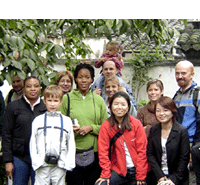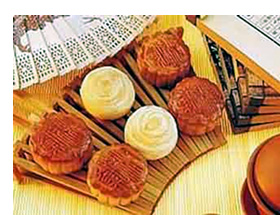 The Lunar New Year, also know as the “Spring Festival”, is a time of great excitement and joy for the Chinese people. The festivities get under way from 22 days prior it the New Year date and continue for 15days afterwards.
The Lunar New Year, also know as the “Spring Festival”, is a time of great excitement and joy for the Chinese people. The festivities get under way from 22 days prior it the New Year date and continue for 15days afterwards.During the time period before New Year, people acquire and prepare the necessary food and new clothing to wear. Food has a major prominence in all Chinese festivals, and New Year is no exception. This is the time for purchasing and eating huge quantities of dried meats and fruits, special sausages, sweet and salty cakes, and numerous other delicacies. Many foods have symbolic value .The Chinese eat leafy Mustard Greens which is called “Eight Treasure Rice”, and fish. The Chinese word for fish rhymes with their word for surplus .By eating hall of a fish on New Year's Eve and saving the remainder for the next day, families can transfer their surplus luck to the New Year.
Families are supposed to clean out their houses, wash all household utensils and discard unwanted items. People also make symbolic sacrifices in honor of the Earth God.
Business owners, in particular, join in this ceremony, because the Earth God is believed to be the god of merchants. Employers are expected to hold a banquet to thanks their workers for their efforts during the past year. On a sour note, during the banquet, it was a custom to point the head of a Chicken in the direction of the person who is to be dismissed .Now, more humane ways are usually found to really the bad news, and most bosses point the head of the chicken at themselves to avoid any problems.
The high point of the season is New Year's Eve. Every member of every family returns home on this day, if possible, to share a sumptuous dinner with his/her family. Children receive “red envelopes “containing gifts of lucky money. Sleep is not easy on this night as the New Year is ushered in with thunderous roar of exploding firecrackers and whistling rockets calculated to frighten the fiercest of evil spirits and venerate the gods .This continues sporadically until after dawn on New Years' Day.
With the coming of the daylight, homes again become a buzz of ceremonial candles are lit, incense and paper money burned and the cacophony of the firecrackers begins anew. Spring poems or couplets, consisting of lucky phrases written in black or golden ink on red paper are pasted on or around every family door. A round of visits follows breakfast on this day. The first stop, traditionally, is made at a local temple, where respects are paid to the gods. Next come visits to relatives and friends.
In the towns and villages, roving bands of musician's parade through the streets stopping at every door they pass to announce, in somewhat raucous strains, the arrival of spring. Each serenaded family presents the groups with “red envelopes “containing a token amount of money. This is another special day for children, who dress up in new clothes and collect more "red envelopes "from their elders.
Certain precautionary measures are taken to insure that the New Year will be a good one. Every house gets a thorough cleaning before New Year's Day so that the Coming New Year will commence fresh and clean. No sweeping is done on New Year's Day, for in sweeping any dirt from the house the family's good luck might also be swept away.
Care must be taken not to break any dishes, and the use of knives, scissors, and any sharp instrument is to be avoided for these things could cause harm and thus bad luck in the coming year.
Hair must be cleaned and set prior to the holiday, for to do so during the New Year season would invite a financial setback. Beauty shops and barbershops take advantage of this by hiking their fees twofold just before the New Year.
New Year is also a time of some trepidation for debtors, since this is when accounts are traditionally settled so that the coming year can be started off with a clean slate.
The days following New Year include more religious ceremonies. The eleventh day is a time for inviting in-laws to dine. The Lantern Festival, on the fifteenth day after New Year, marks the end of the New Year, marks the end of the New Year season.





 The Lantern Festival closes the New Year festivities. This holiday evolved from ancient Chinese beliefs that celestial spirits could be seen flying about in the light of the first full moon of the lunar calendar. To aid them in their search for the spirits, they used torches. These torches gave way to lanterns of every conceivable size, color and shape. Now, the Lantern Festival is celebrated on the fifteenth day of the fist month of the lunar calendar.
The Lantern Festival closes the New Year festivities. This holiday evolved from ancient Chinese beliefs that celestial spirits could be seen flying about in the light of the first full moon of the lunar calendar. To aid them in their search for the spirits, they used torches. These torches gave way to lanterns of every conceivable size, color and shape. Now, the Lantern Festival is celebrated on the fifteenth day of the fist month of the lunar calendar. One day, ten suns suddenly appeared in the sky. The emperor, greatly perturbed and fearful that this occurrence presaged some great evil to his people, ordered HouYih, an expert archer, to shoot nine of the suns out of the sky. The great skills with which Hou Yih accomplished this feat impressed the Goddess of the Western Heaven.
One day, ten suns suddenly appeared in the sky. The emperor, greatly perturbed and fearful that this occurrence presaged some great evil to his people, ordered HouYih, an expert archer, to shoot nine of the suns out of the sky. The great skills with which Hou Yih accomplished this feat impressed the Goddess of the Western Heaven.